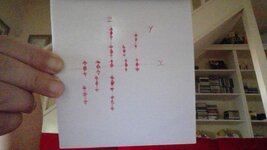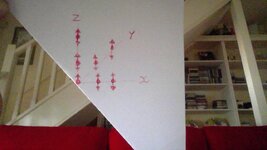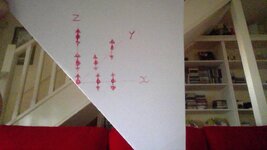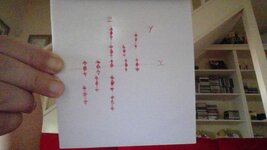KitchenFly
Active member
- Joined
- Feb 5, 2015
- Messages
- 759
21:59/27:31 ∃x∈ℜ ∀y∈ℜ, x<y is a false statement because we can not find a special case.
Or does one or more special case exist.
∃x∈ℜ ∀y∈ℜ, x<y may not be a false proposition. The reason being it is said that 95% of the universe is unseen from the observable 5% the directly relates to our existence.
∃x∈ℜ ∀y∈ℜ, x<y may a true proposition.
Let x be the number -273.15 v -274.15 v -275.15 v -276.15 and let y be the a number zero any zero contained within the Set of all zeros contained within the dark energy number.
The Dark energy number. {.00000000000000000000000000000000000000000000000000000000000000000000000000000000000000000000000000000000000000000000000000000000138}
Rule one: A number viewed from the hundred's Column must be counted three times as if it has the same count in the ten's Column and the units Column. A number viewed in the tens Column must be counted two times as if it has the same count in the tens Column as if in the units Column. And the units are counted once.
Rule two: Any number/ numbers on the other side of the decimal point is are treated differently. They are simply added to create a sum tally number.
Apply rule one and rule two:
-273.15 Absolute Zero.
-274.15 One degree below.
-275.15 Two degrees below.
-276.15 Three degree below.
2 = 6 Zero's, 7 = 14 Zeros, 3 = 3 Zero's, (decimal point) 1 + 5 = 6. -273.15 (6 + 14 + 3 + 6 = 29) Twenty nine zeros.
2 = 6 Zero's, 7 = 14 Zeros, 4 = 4 Zero's, (decimal point) 1 + 5 = 6. -273.15 (6 + 14 + 4 + 6 = 30) Thirty zeros.
2 = 6 Zero's, 7 = 14 Zeros, 5 = 5 Zero's, (decimal point) 1 + 5 = 6. -273.15 (6 + 14 + 5 + 6 = 31) Thirty one zeros.
2 = 6 Zero's, 7 = 14 Zeros, 6 = 6 Zero's, (decimal point) 1 + 5 = 6. -273.15 (6 + 14 + 6 + 6 = 32) Thirty two zeros.
29 + 30 + 31 + 32 = 122
Fifty-four elemental parts are said to make up the standard model of particle physics. Yes, there is a 54 within the number pattern on the left-hand side of the decimal point. 2 + 2 + 2 + 2 + 7 + 7 + 7 + 7 + 3 + 4 + 5 + 6 = 54.
Rule two: Any number/ numbers on the other side of the decimal point is are treated differently. They are simply added to create a sum tally number.
1 + 5 = 6
1 + 5 = 6
1 + 5 = 6
1 + 5 = 6
6 + 6 + 6 + 6 = 24
How many quantum fields are there? The answer is 24.
The quarks and leptons are fermions, which is why they have antimatter counterparts, and the W boson comes in two equal-and-opposite varieties (positively and negatively charged), but all told, there are 24 unique, fundamental excitations of quantum fields possible.
1 +1 +1 1+1 +1 decimal point 1 + 5
1 +1 +1 1+1 +1 decimal point 1 + 5
1 +1 +1 1+1 +1 decimal point 1 + 5
1 +1 +1 1+1 +1 decimal point 1 + 5
............. 24 ............................................ 24
The component on the right hand side of the the decimal point 1 + 5 = 6 it reminds me of M theory five maths unified by one math making six maths.
An alternative way of viewing the 122 zeros is to invision them as nesting octaves with nine unit values evenly spaced on each side of each of the 122 zeros. Such a Set structure would be friendly to the Enneagram because there ∃! a Set of eighteen egoic mind sets and each egoic mind set is required for the workings of logic applied via the human mind.
- Feeling at the Instinctual level Points one and two. Self Preservation Instinct.
- Thinking at the Instinctual level Points four and five. Sexual Instinct.
- Sensing at the Instinctual level Points seven and eight. Social Instinct.
The 18 egoic mind set's.
The Feeling Triad
Two with one wing.
Subtype: two with one-wing; ENFJ
Auxiliary wing: one with nine-wing; ExTJ (Ambidextrous S and N) (agenda focused)
Second/wing: ISTJ (mood focused)
Point of stress/disintegration: eight with nine-wing; ESFJ
Point of Integration/Neurosis: four with five-wing; ENTP
Two with three wing.
Subtype: two with three-wing; ISFJ
Auxiliary wing: three with four-wing; ISTP (agenda focused)
Second wing: ESTJ (agenda focused)
Point of stress/disintegration: eight with seven-wing; ESTP
Point of Integration/Neurosis: four with three-wing; ENFP
Three with two wing.
Subtype: three with two-wing; ISTJ
Auxiliary wing: two with one-wing; ENFJ (agenda)
Second wing: ENFP (mood focused)
Subsidiary wing: one with two-wing; ESTJ
Subsidiary wing: five with Six-wing; INxP (Ambidextrous T and F)
Point of stress/disintegration: nine with one-wing; INFP
Point of Integration/Neurosis: six with five-wing; INTJ
Three with four wing.
Subtype: three with four-wing; ISTP
Auxiliary wing: four with-five; ENTP (agenda)
Second wing: two with three-wing; ISFJ (mood)
Subsidiary wing: five with four-wing; INTP
Subsidiary wing: one with nine-wing; ExTJ (Ambidextrous S and N)
Point of stress/disintegration: nine with eight-wing; INFJ
Point of Integration/Neurosis: six with seven-wing; ISFP
Four with three wing.
Subtype: four with three-wing; ENFP
Auxiliary/wing: three with two-wing; ISTJ (agenda focused)
Second/wing: INTP (mood focused)
Point of stress/disintegration: two with three-wing; ISFJ
Point of Integration/Neurosis: one with two-wing; ESTJ
Four with five wing.
Subtype: four with five wing; ENTP
Auxiliary wing: five with six wing; INxP (Ambidextrous T and F) (agenda focused)
Second wing: ISTP (mood focused)
Point of stress/disintegration: two with one-wing; ENFJ
Point of Integration/Neurosis: one with nine-wing; ExTJ (Ambidextrous S and N)
The Doing Triad/Thinking Triad
Five with four-wing.
Subtype: five with four-wing; INTP
Auxiliary wing: four with three-wing; ENFP (agenda focused)
Second wing: ISFP (mood focused)
Point of stress/disintegration: seven with six-wing; ESFP
Point of Integration/Neurosis: eight with nine-wing; ESFJ
Five with six-wing.
Subtype: five with six-wing; INxP (Ambidextrous T and F)
Auxiliary wing: six with seven-wing; ISFP (agenda focused)
Second wing: ENTP (Mood focused)
Point of stress/disintegration: seven with eight-wing; ENTJ
Point of Integration/Neurosis: eight with seven-wing; ESTP
Six with five-wing.
Subtype: six with five-wing; INTJ
Auxiliary wing: five with four-wing; INTP (agenda focused)
Second wing: ENTP (mood focused)
Subsidiary wing: four with three-wing; ENFP
Subsidiary wing: eight with nine-wing; ESFJ
Point of stress/disintegration: three with two-wing; ISTJ
Point of Integration/Neurosis: nine with one-wing; INFP
Six with seven-wing.
Subtype: six with seven-wing; ISFP
Auxiliary wing: seven with eight-wing; ENTJ (agenda focused)
Second wing: INFTP (mood focused)
Subsidiary wing: four with five-wing; ENTP
Subsidiary wing: eight with seven-wing; ESTP
Point of stress/disintegration: three with four-wing; ISTP
Point of Integration/Neurosis: nine with eight-wing; INFJ
Seven with six-wing.
Subtype: seven with six-wing; ESFP
Auxiliary wing: six with five-wing; INTJ (agenda focused)
Second wing: ESTP (mood focused)
Point of stress/disintegration: one with nine-wing; ExTJ (Ambidextrous S and N)
Point of Integration/Neurosis: five with four-wing; INTP
Seven with eight-wing.
Subtype: seven with eight wing; ENTJ
Auxiliary wing: eight with nine wing; ESFJ (agenda focused)
Second wing: ESFP (mood focused)
Point of stress/disintegration: one with two wing; ESTJ
Point of Integration/Neurosis: five with six wing; INxP(Ambidextrous T and F)
The Relating Triad/Instinctive Triad
Eight with seven-wing.
Subtype: eight with seven-wing; ESTP
Auxiliary wing: seven with six-wing; ESFP (agenda focused)
Second wing: INFP (mood focused)
Point of stress/disintegration: five with six-wing; INxP (Ambidextrous T and F)
Point of Integration/Neurosis: two with three-wing; ISFJ
Eight with nine-wing.
Subtype: eight with nine-wing; ESFJ
Auxiliary wing: nine with-eight; INFJ (agenda focused)
Second wing: ENTJ (mood focused)
Point of stress/disintegration: five with four-wing; INTP
Point of Integration/Neurosis: two with one-wing; ENFJ
Nine with eight-wing.
Sub-type: nine with eight-wing; INFJ
Auxiliary wing: eight with seven-wing; ESTP (agenda focused)
Second wing: ESNTJ (mood focused)
Subsidiary wing: seven with eight-wing; ENTJ
Subsidiary wing: two with three-wing; ISFJ
Point of stress/disintegration: six with seven-wing; ISFP
Point of Integration/Neurosis: three with four-wing; ISTP
Nine with one-wing.
Subtype: nine with one-wing; INFP
Auxiliary wing: one with two-wing; ESTJ (agenda focused)
Second wing: ESFJ (mood focused)
Subsidiary wing: two with one-wing; ENFJ
Subsidiary wing: seven with six-wing; ESFP
Point of stress/disintegration: six with five-wing; INTJ
Point of Integration/Neurosis: three with two-wing; ISTJ
One with nine-wing.
Subtype: one with nine-wing; ExTJ (Ambidextrous S and N)
Auxiliary wing: nine with one-wing; INFP (agenda focused)
Second wing: ISFJ (mood focused)
Point of stress/disintegration: four with five-wing; ENTP
Point of Integration/Neurosis: seven with six-wing; ESFP
One with two-wing.
Sub-type: one with two-wing; ESTJ
Auxiliary wing: two with three-wing; ISFJ (agenda focused)
Second wing: INFJ (mood focused)
Point of stress/disintegration: four with three-wing; ENFP
Point of Integration/Neurosis: seven with eight-wing; ENTJ
Mark Anthony Rockliff 9w1 INFP Sx/Sp/So 1221 D type.
Last edited:




